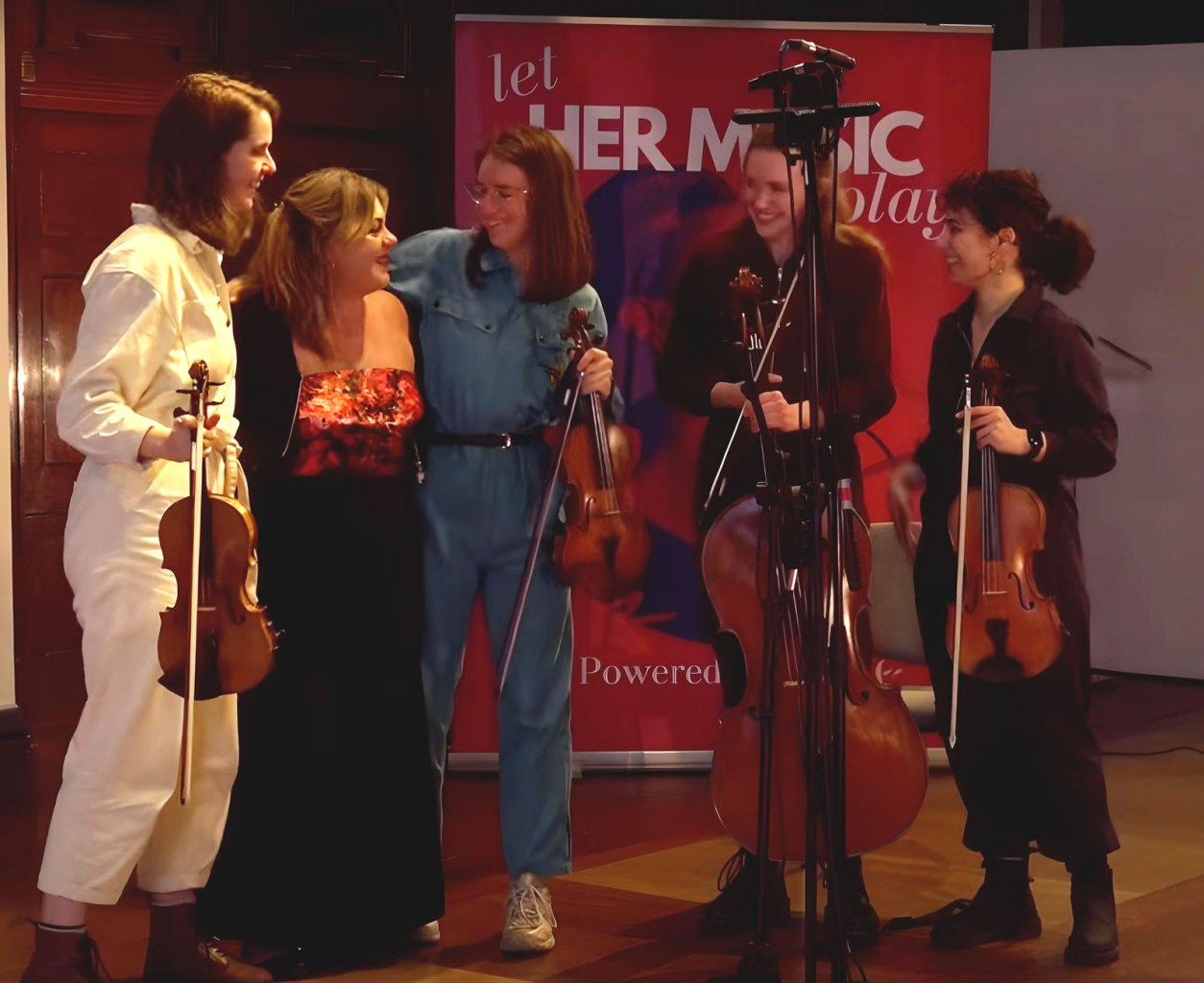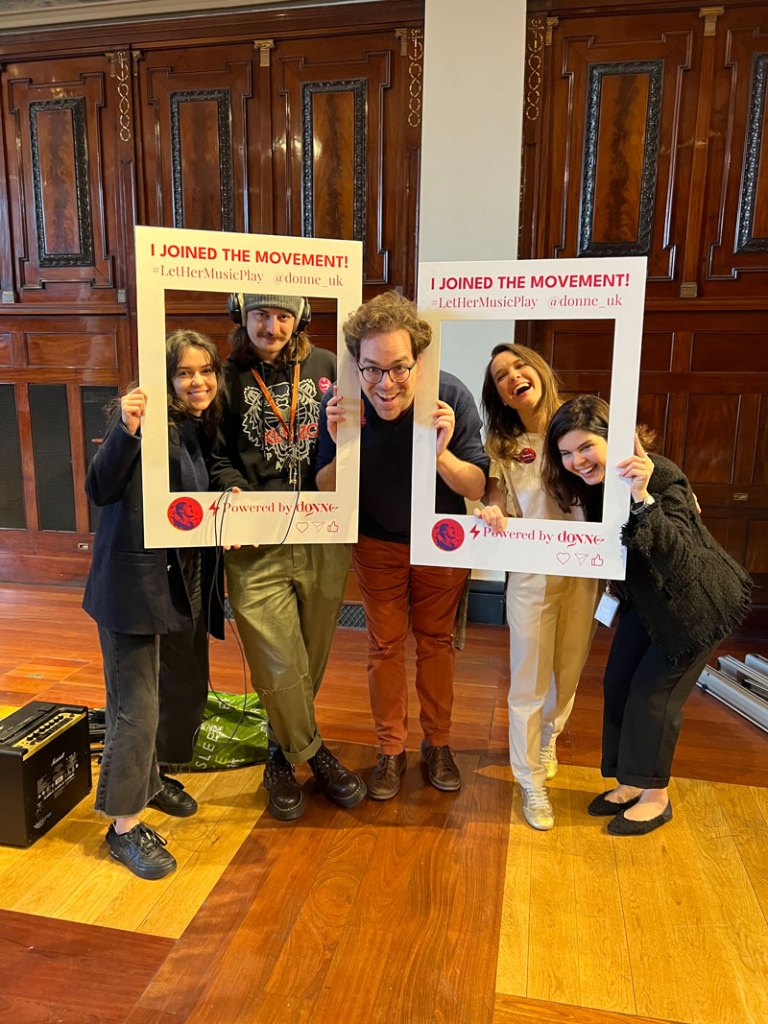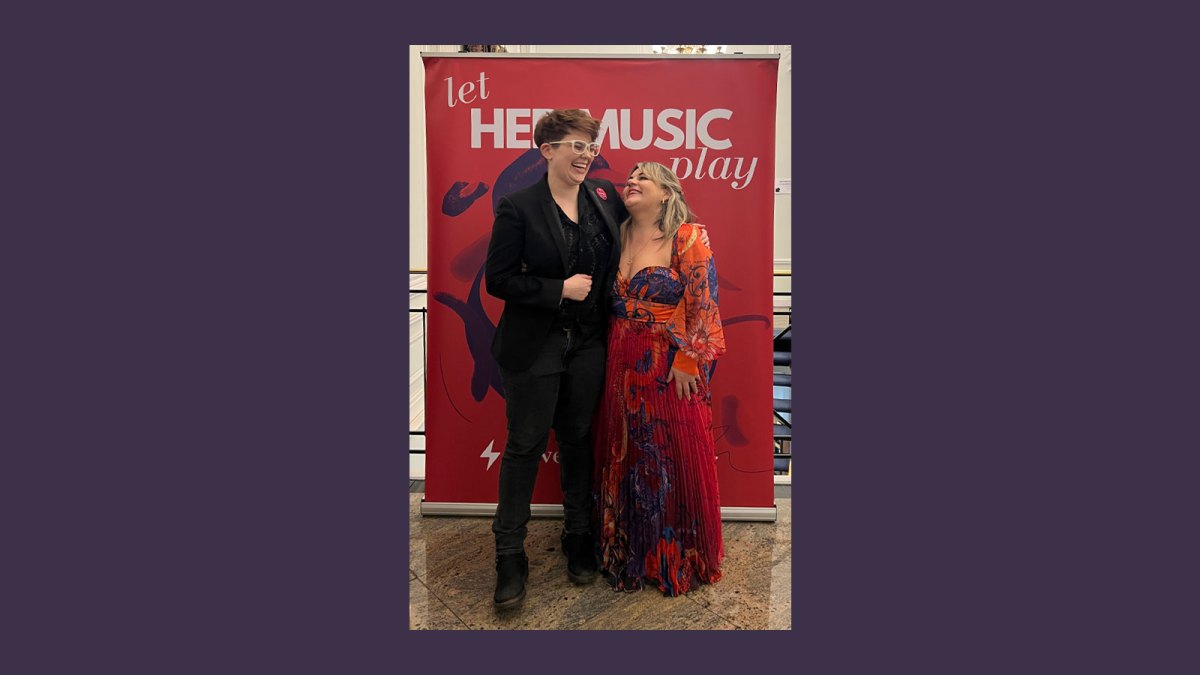When I enter London’s Brazilian Embassy at 6.49 p.m., “Let HER Music Play” is already six hours old, but only a quarter of the way through. Organized by the Donne Foundation, which advocates for women in the music industry, it’s an attempt to break the Guinness World Record for the longest acoustic live-streamed concert using music solely by female and non-binary composers and songwriters. The hall is only half full as I enter, but as far as the record goes, that doesn’t matter so much; there’s a hundred or so people watching the concert online.
The embassy hall is a large, wood-paneled affair, with assorted murals filling the rest of the space: large tableaus of boats appear in the background of the performers’ shots, but there are sphinxes on other walls, and St. George slaying the dragon overhead. But the hall’s biggest feature is its windows that look out onto a key central London tributary, lending the space the air of a high-end showroom. On the corner of Pall Mall and Haymarket, round the corner from Trafalgar Square, there’s a steady stream of traffic even as rush hour thins out. Black taxis, red buses, and a fair few tourists amble past in the background; it’s a picture-postcard London scene.
In order to break “the Guinness,” as Donne founder Gabriella Di Laccio calls it, certain rules have to be followed: no piece is to be repeated within a four-hour timeframe; no amplified instruments are allowed; and, though one five-minute comfort break is allowed every hour, otherwise, there’s a maximum of 60 seconds between acts. It’s less a concert and more a musical Gantt chart, a skeleton clock of an event with all its workings on show. As I bed in for the evening, pianist Maria Garzon presents two crisp sonatas by Marianna Martines in the most throwaway fashion: by the time the applause begins, Garzon has torn away the sheet music from the stand.
In spite of its absurdity, or maybe because of it, record breaking is a reflection of our deepest interests and desires,” Imogen West-Knights wrote in The Guardian last May. For Di Laccio, the record attempt is an ambitious next step in Donne’s ongoing advocacy project. “I feel like we really need to shift from individual initiatives to collective action to be stronger,” she says.
There are various aspects to the Donne Foundation’s work, most of them maximal in scope. There’s the excellently titled Big List, a large and growing database of over 5,000 female composers, a series of reports on diversity in the wider music industry, and data on performances by non-male composers by orchestras worldwide, with some stark conclusions. “Let HER Music Play” is in the same ambitious vein: 90-or-so musicians, scheduled for 26 hours and 20 minutes of non-stop music. “A Guinness World Record is something that grabs people’s attention,” she says. “I wanted to create a movement that would connect with people in a different way.”
But Donne’s ability to lead such a movement comes up against the age-old problem of money. Started in 2018 as a passion project by Di Laccio, Donne still exists without regular funding or sponsorship, a situation which seems at odds with the wider acceptance of similar diversity and inclusion initiatives in the UK. Might a World Record attempt be the chance to secure more financial support?
The latest from VAN, delivered straight to your inbox
At some point during Irish singer-songwriter Blánid’s set (8:30 p.m.), baritone Roderick Williams sits down next to me, and gives an enthusiastic thumbs up to her question, “Has anyone seen ‘Airplane II’?” He’s on next, and, with pianist Iain Burnside, they put forward a good demonstration of how to creatively approach repertoire by non-male composers in this kind of context. Informing the audience that much of the following song repertoire was new to him until just a few years ago, the set is imaginative and curious, connecting music through ideas: pairing Rebecca Clarke and Alma Mahler through their settings of Richard Dehmel, comparing Shakespeare settings across languages, raising an eyebrow at gender in performance through Joy Trimble’s “My Grief on the Sea” (“And my Love came behind me / He came from the South / His breast to my bosom / His mouth to my mouth”) and all the while suggesting this music is connected to a bigger corpus of song. Where Roger Quilter’s “Take, o take my lips away” leans sentimental, Madeleine Dring’s setting, with echoes of Purcell, is raw and sensual; W.B. Yeats’s “Down by the Salley Gardens,” set so memorably by Benjamin Britten and also by John Ireland and Ivor Gurney, is wide-open and vulnerable in the hands of Rebecca Clarke.

At 9:05, I feel my first yawn coming on, quickly followed by my second. I’ve only done one of these through-the-night concerts before. There, doubting my ability to stay awake, but also leaning into the grimness of it all, I guzzled coffee in the vague hope it would help, meaning I was too awake for Gavin Bryars’ “Jesus’ Blood Never Failed Me Yet,” and too asleep for “Verklärte Nacht.” “Let HER Music Play” is an altogether more alert affair, though. People are constantly moving: in and out of the room, on and off stage, to and from the mixing desk. The pieces—most of the program relates back to song—are short, meaning applause is never more than a few minutes away.
At 9:48, as the applause changes character—from cumulative to slightly startled, and deliberately loud—it feels necessary to count the number of people still in the room: One group of four in a three-one formation across two rows, two organizers guarding backstage, one woman on her phone, one man with his arms crossed, three at the mixing desk, one audience member sitting directly behind them, a couple who arrived together and seem in it for the long haul, a woman walking across my view to sit down next to the crossed-arms man, the pianist, Beatrice Nicholas, playing Florence Price’s beautifully dreamy “Clouds,” and me at the back. I’m not sure what I expected, but I think I’d assumed—hoped?—that there would be more people here. I can just about see over the shoulder of the camera operator, and the YouTube view count is healthy, though I wonder how many of those in the room might also be tuned in online.
I head out for a walk and return to a room that’s noticeably swelled. There’s a distinct Brazilian theme to the evening: Brazilian-born Di Laccio has used her contacts to fill in some of gaps, including three back-to-back sets of melancholic vocalist-guitar tunes from Analu Sampaio—at 15, surely a star of the future—Vanessa Moreno, and, finally, Latin GRAMMY-winner Adriana Calcanhotto, who flew over from Brazil for the performance. The room is a different kind of quiet now; focused, rather than spare, made of minimal movements, rather than people trying to minimize their many movements. It turns out that the Portuguese-speaking contingent knows all of the words to Calcanhotto’s post-bossa nova tunes, but the music is all so quiet, so unamplified, that the crowd sings along to themselves. In a room of people singing along sotto voce, imperceptibly except for the occasional whistle-y “s” sounds, I lose an hour and a half.
I felt like it was never boring,” Di Laccio later reflects on the event. There are six people in the audience when, at 1:43 a.m., John Holland and his small group of wind and brass players start blasting Linda Perry’s “Get The Party Started.” They play loudly and lustily, with music from Japanese neo-noir series ”Cowboy Bebop,” “Aria,” by Australian composer Dulcie Holland, a setting of the Christmas carol “Infant Holy,” and Annie Lennox’s 1992 hit “Walking on Broken Glass,” constructing the kind of fever-dream, what-on-earth-OK-fine-we’re-doing-this program that could only be executed by a wind ensemble. Holland conducts and adds percussion—temple blocks, wind chimes—while he plays his other instruments. It’s nuts, in an extremely endearing way.
At 2:11, I am, inexplicably, playing in the band. I’m handed one of those heavy-duty shakers that needs a solid level of technique to get any sort of consistency, and I’ve got to somehow make sixteenth notes happen, constantly, for the full duration of Chiquinha Gonzaga’s “Corta-Jaca.” I quickly realize this is impossible, and end up settling for the most staid, sexless reggaeton pattern imaginable. (Chiquinha, I know you’re dead, but I’m sorry all the same.)
Soon it’s the hour of the night-owl ultras: James Akers delves into Emilia Guiliani’s fiery pieces for solo guitar (3:15 a.m.), Elizabeth Hardman valiantly pings out top A after top A (4:37 a.m.), and tenor Timothy Parker-Langston accompanies himself from the piano in ultra-hushed Fanny Hensel songs (5:34 a.m.) which he works through with only the smallest breaks. After 20 minutes, he starts to look to the organizers about when exactly he’s supposed to stop. Each time, they make a swirling, repeat motion with their hands, and each time, he replies with another hushed song.
I depart at 6:20.
A few days later, I have a video call with Di Laccio. Have they broken the World Record? The answer is… probably? There’s still a lot of boring paperwork for Donne to complete, followed by a verification process from Guinness record-keepers, meaning they probably won’t know for sure for a little while, but she’s confident that they’ve stuck to the rules, even if some cracks appeared on the day. (A couple of impromptu a capella songs appeared mysteriously on the program to fill the gaps for toilet breaks and late arrivals.)
Obviously, “the Guinness” isn’t the important thing, she says, because “the message was bigger.” But the message—in her words, “moving, magical, transformational”—also comes with a warning. All the musicians, from amateurs to students to professionals, took part in the attempt for free. The livestream operators were graduates from Abbey Road seeking hands-on experience, and the only person paid during the event was the videographer, who, even then, worked at a heavily discounted rate. The Brazilian Embassy provided the room and the site-staff free of charge, and there were donations from the Musicians’ Union, the Independent Society of Musicians and a handful of other smaller organizations, but otherwise, sponsorship was thin on the ground. This was not for want of trying. “I knocked on all the doors,” Di Laccio says. “I was emailing, I was calling music organizations, non-music organizations, you know, big companies, I’m saying to them all, you just missed out on a massive opportunity.”

It’s worrying in a wider sense, too. As VAN has reported recently, public subsidy for the arts is falling apart in the UK, with Birmingham and Glasgow councils the latest to announce reductions or eliminations of arts funding as they attempt to cut costs. Whether it likes it or not, the UK arts sector is going to have to look to the private sector and independent philanthropy to shore up the gaps left as public subsidy retreats. You’d have thought that “Let HER Music Play,” a one-off event in central London, with a broadly progressive—though rarely explicitly political—outlook, a central message of diversity and inclusion, a welcoming of a variety of genres, a very visible online presence, and a strong, diverse set of performers would have been a boon for sponsorship. That it wasn’t should be a concern for arts fundraisers everywhere.
Di Laccio begins our call by apologizing for not being able to speak while the performance was happening; as well as masterminding the whole thing, she also sang multiple times throughout the event. “I’m still tired, and still recovering,” she says. “But it gave me such an energy to continue this and to make it even bigger each time.” I don’t doubt it, though she says the longest concert ever, at some 900 hours, is a little beyond Donne right now. The nagging feeling, though, is this: What happens when individuals like Di Laccio run out of energy? ¶
Subscribers keep VAN running!
VAN is proud to be an independent classical music magazine thanks to our subscribers. For just over 10 cents a day, you can enjoy unlimited access to over 875 articles in our archives—and get new ones delivered straight to your inbox each week.
Not ready to commit to a full year?
You can test-drive VAN for one month for the price of a coffee.


